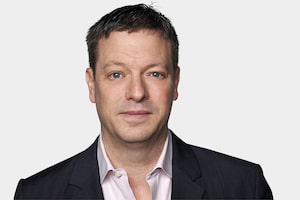
Servicemen of Ukraine's Azov Battalion pray in the Ukraine's second-biggest city of Kharkiv on March 11, 2022, following Russia's invasion of Ukraine.SERGEY BOBOK/Getty Images
Have you heard about the Nazis in Ukraine?
Probably, if you’ve listened to Vladimir Putin’s speeches justifying his invasion, which tend to include claims that it is a “denazification” of a country overrun by fascists.
Or quite possibly, if you follow certain social-media accounts or U.S. TV shows – most on the “anti-imperialism” far left or the “globalist conspiracy” right, but some more mainstream. These commentators make the case either that Vladimir Putin has a point, or that neither Russia nor Ukraine ought to receive Western backing because they’re corrupt and hateful foreign lands.
If you follow these, you’ve seen images of Ukrainians wearing swastikas or other extreme-right or nationalist symbols, suggestions that the Ukrainian parliament contains fascists, and a lot of talk of the “neo-Nazi Azov Brigade,” described as a major part of the Ukrainian army packed with white-supremacist foreign fighters, like a Slavic al Qaeda.
The photos of swastika-wearing soldiers aren’t fake. The extreme right in Ukraine does exist; I’ve interviewed some of its key figures, who were visible on the sidelines of the 2014 pro-European Union protests that provoked the first Russian invasion. They’re street thugs and former soccer hooligans, and they really do say hateful things about Jews, Muslims and gay people.
They also have almost no support among actual Ukrainians. There are five registered political parties far enough to the right that they might fairly be called “Nazi.” Four of them hold zero seats in the national parliament, and are probably unknown to most Ukrainians. The oldest and best-known, Svoboda (whose leaders model themselves on 1940s nationalist and Nazi collaborator Stepan Bandera), holds exactly one of the 450 seats. In the 2019 national election, the combined vote for all five parties was 2 per cent (similar parties get 10 per cent in Germany and a third of the vote in France). That was the same year three-quarters of Ukrainians voted for a Jewish, pro-European Union president, Volodymyr Zelensky.
In February, 2014, leaders of the Ukrainian white-supremacist group Right Sector told me that, aside from electoral politics, their other big ambition was to form a volunteer militia. Three months later, as Russian-backed forces overran eastern Ukraine, this resulted in the creation of the Azov Battalion. It was one of at least 16 volunteer militias created by Ukrainians to fight Russians in the east – but it attracted the most attention, in part because it claimed to be attracting neo-Nazis from North America and Western Europe.
Military brigades run by extreme-right figures promoting race hatred are not unique to Ukraine. It was a similar-minded group of extreme-right figures, and the deadly racial atrocities they committed, that forced Ottawa to disband the Canadian Airborne Regiment in 1995. Russia has more than one such brigade, which also attract foreign fighters.
Why didn’t the Ukrainian government follow Canada’s lead and banish the Azov creeps? For one thing, it needed all the armed fighters it could get in 2014, when the Ukrainian military was tiny and receiving no Western assistance. For another, it actually did disband the Azov Battalion. In late 2014, it was absorbed into the military, renamed the Azov Regiment, and subjected to a screening process theoretically intended to keep out dangerous extremists (though it probably didn’t).
“The importance of this group is massively exaggerated.” So says Kacper Rekawek of the Oslo-based Center for Research on Extremism, who authored a research report on the role of “extreme right-wing” foreign fighters on both the Russian and Ukrainian sides of the war. ”We’re still discussing Azov based on its image from 2014. That’s exactly what the Kremlin wants.”
Currently, the Azov Regiment is estimated to have about 900 fighters, all of them based in the eastern city of Mariupol, which is being savagely shelled by Russian forces. The Ukrainian armed forces contain 215,000 combat personnel. Azov, the only overtly extreme-right faction in those forces, makes up less than half of one per cent of the Ukrainian military.
Nor has it succeeded in drawing figures from hate groups abroad. The German agency that monitors far-right activity said this month that there have been “fewer than ten cases” observed of extremists going to fight in Ukraine – and researchers have repeatedly pointed out that most of them are going there to fight on the Russian side of the battle.
That makes sense. As Mr. Rekawek’s report concludes, one of the few things that unites members of the Western far right is an admiration for Mr. Putin, who has backed or inspired their political parties in many countries. While there’s never anything good about hateful extremists in uniform, the share who are drawn to an anti-Putin, pro-EU fight in a country led by a Jew is not large enough to deserve our attention.
Keep your Opinions sharp and informed. Get the Opinion newsletter. Sign up today.
 Doug Saunders
Doug Saunders